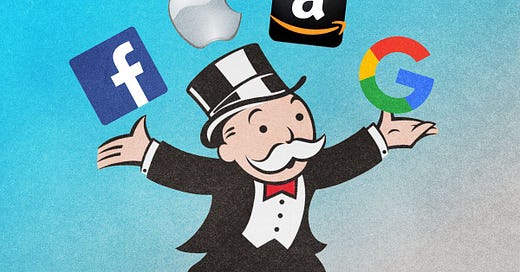In the past few months, we’ve had some great news in the never-ending fight to counter big tech’s monopolistic stranglehold.
Google was ruled against in an anti-trust case for its advertising monopoly
Twitter also scored an anti-trust win against the advertising industry
And, last but not least, Amazon was ruled to be a distributor!
All good progress, but unfortunately still nothing conclusive as these rulings can be appealed and contested before any actual penalties are truly implemented.
Unfortunately, wins against big tech have been far and few between, in both the judiciary and legislative branches of government.
Our opinion is that one of the best ways to hold big tech accountable is on a local or state level. Case in point, Texas’ lawsuit against Facebook and the $1.4 Billion settlement. This follows a similar case in Illinois which received a $600M settlement. Where are the other state lawsuits?!
In this week’s newsletter, we’ll discuss:
Amazon being classified as a Distributor. Good or Bad?
SaaS to Marketplace Evolution: Rise of eProcurement
Top 50 B2B Marketplace Fundraising
List of Most Active VC Investors in B2B Marketplaces
Bonus: List of Most Active VC Investors in all of Distribution Tech
Amazon ruled a Distributor. Good or bad?
The US Consumer Product Safety Commission (CPSC) ruled that Amazon is a distributor:
“In a unanimous vote, the Commission determined that Amazon was a “distributor” of products that are defective or fail to meet federal consumer product safety standards, and therefore bears legal responsibility for their recall. More than 400,000 products are subject to this order: specifically, faulty carbon monoxide (CO) detectors, hairdryers without electrocution protection, and children’s sleepwear that violated federal flammability standards.”
The true impact on Amazon is far from certain. The CPSC has told Amazon it needs to implement more safeguards in specific product categories. However, Amazon can appeal the decision. And, what authority does the CPSC have to impose a fine? Not to mention, the preliminary complaint was issued in 2021 by the CPSC and three years later, this ruling is then made. Considering Amazon can still appeal, that means we still have a long way to go until anything is final.
Amazon being help accountable is positive for a company with its size and market dominance. However, this will be a net-negative ruling if other up-and-coming B2B marketplaces are also mandated to implement the same safeguards and policies. Why? Because it will actually stifle competition. Amazon has the resources to invest in an army of compliance and process if it has to. Startups don’t. They don’t have billions of profits that they can tap into because of a regulatory mandate. We’ve seen this happen before – GDPR in Europe had an unintended effect of entrenching the tech monopolies rather than reining them in.
SaaS to B2B Marketplace Evolution
There’s a second wave of B2B Marketplaces coming, and they didn’t start as a B2B Marketplace. Instead, they started as a SaaS tool helping the customer of B2B distribution such as roofers, electricians, contractors, dentist offices, veterinarian clinics, cosmetic brands and factories. The software helps manage the customer’s operations, schedule jobs and do cost reporting. Think of these software tools as the “operating system” for the small-mid size customer to B2B distribution.
The key thing all these tools do: inventory management.
These software tools help the SMB customer with inventory management, but, historically, they wouldn’t help with the procurement of the materials. They would just help manage the existing inventory on hand and the customer would figure out how to procure more supplies whenever needed. This was when the software was still just a SaaS tool.
Now, in 2024, these software tools have an insatiable appetite to assist the SMB customer with the procurement of the materials. Enter: eProcurement and the second wave of B2B Marketplaces.
eProcurement is the second coming of the B2B Marketplace
eProcurement is very different than Phase 1 of B2B Marketplaces. Phase 1 wasn’t integrated into the customer’s existing system of record. An SMB customer would need to go to a separate website with a shopping list and procure those materials. This was a completely separate experience and workflow to the SMB customers’ day-to-day activities.
eProcurement is seamless and closed loop.
With this second wave of B2B marketplaces and integrated eProcurement, the SMB customer can purchase their materials all in one seamless experience. And, after they purchase, those material and inventory counts automatically update in their “operating system.”
The greatest proponent of the SaaS to B2B Marketplace evolution is actually the SMB customer. Yes, of course, the tech startup wants to become a marketplace – but the startup is primarily listening to the needs of their customer. The customer wants an integrated experience.
And, very often, it isn’t just the tech startup putting pressure on the distributor. It’s the customer. The customer is the one asking B2B distributor to integrate into the SaaS/marketplace software tool to make it easier for them to buy and manage their business. If you’re not integrated the customer will ask, “Why are you making my life harder?” And they may go buy from someone else.
That’s what makes eProcurement B2B marketplaces so powerful and sticky. How can a B2B distributor say no to their most valuable customers? The answer often is: they can’t.
Slowdown in Funding to B2B Marketplaces
As we see the rise of eProcurement B2B marketplaces, we are seeing a slowdown with overall B2B Marketplace funding. We track our Top 50 B2B Marketplaces and how they have fundraised from 2023 through the first half of 2024.





